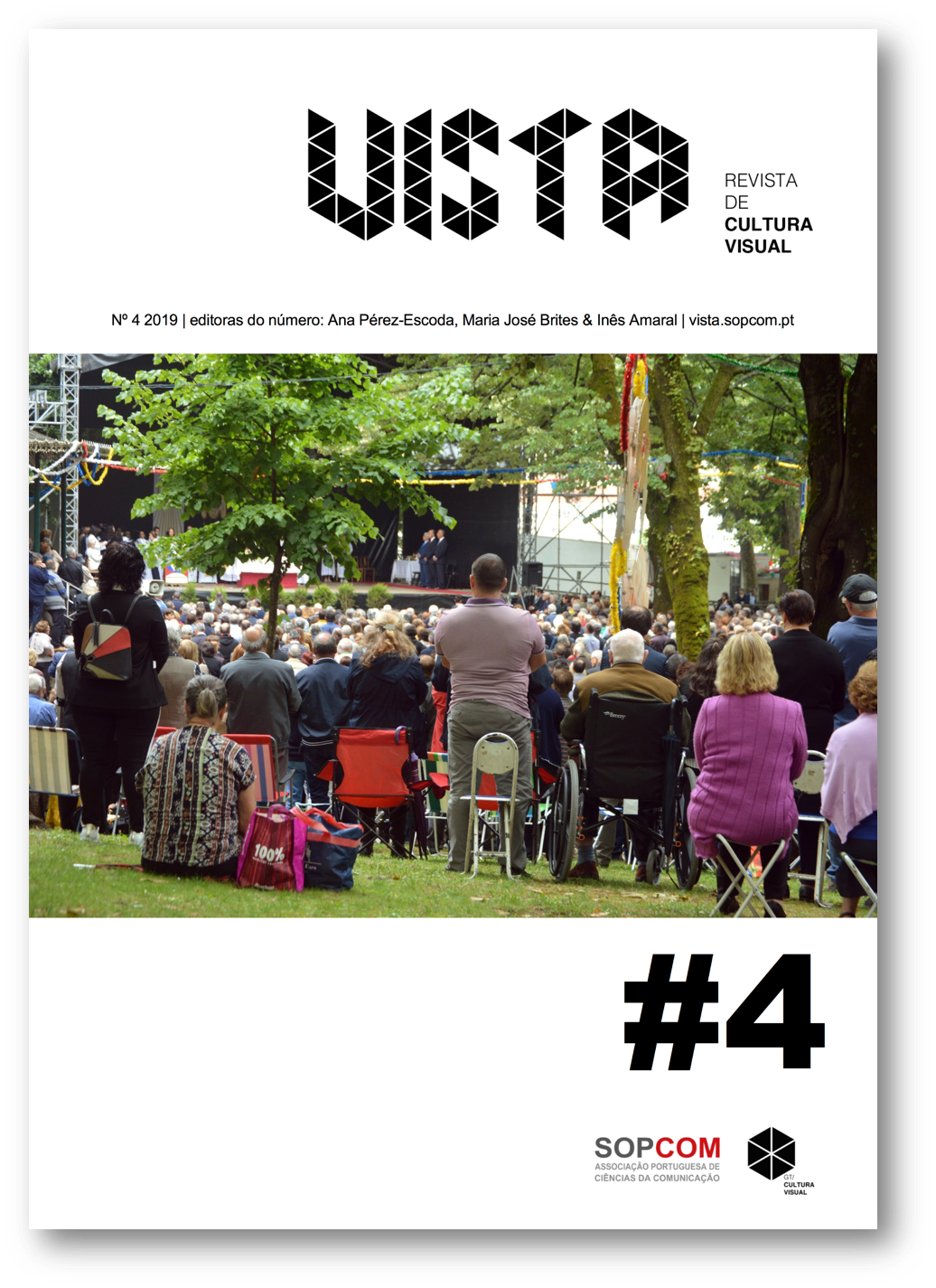Leveraging social media induced visual culture for body image enhancement: The case of socialization in a contemporary society
DOI:
https://doi.org/10.21814/vista.3018Keywords:
social media, digital age, visual culture, socialization, body image enhancementAbstract
There are a variety of mediums through which the phenomenon of socialization is elicited. One of such means is social media platforms. But benefiting from this medium is dependent on the attribute of being technologically savvy intergenerational dynamics notwithstanding. This mixed methods study investigates the influence of social media on cultural connotations of socialization and body image enhancement, and how they shape changes in appearances. Use was made of survey [n=361] data to explore social media dynamics in relation to the process of socialization, while the interview [n=10] data explicated the issues raised in the frame of cross-sectional design. Bivariate and thematic analyzes were respectively conducted. The findings indicate that intergenerational outcomes of the uses of social media between younger and older people is skewed towards younger people and the inherent gap therefore pertains. The Cramer’s V test value of .612 intimates a strong association between social media’s visual images and the type of body image enhancement undertaken. This has implications for technological literacy among older Ghanaian adults. The culture of body image enhancement is learned and therefore has been learned through social media induced socialization by virtue of social media’s oriented social interaction. Put differently, this form of socialization unleashes the availability, accessibility and exposure to certain images that precipitate a desired need for transformation of an existing body image. By and large, culture is created and transmitted from generation to generation. This paper offers newer insights into the phenomenon of socialization and the attendant lifestyle change nemesis, outlining the fact that the effects of social media imagery in both text and visual images is socialization.
Downloads
References
Andsager, J. L. (2014). Research directions in social media and body image. Sex Roles, 71(11 -12), 407–413. http://doi.org/10.1007/s11199-014-0430-4.
Bailey, K. A., Gammage, K. L., van Ingen, C., & Ditor, D. S. (2015). “It’s all about acceptance”: A qualitative study exploring a model of positive body image for people with spinal cord injury. Body Image, 15, 24–34. http://doi.org/10.1016/j.bodyim.2015.04.010.
Barthes, R. (1977). Rhetoric of the image, in Heath (Ed.). Image, music, text (pp. 32-51), New York: Hill and Wang.
Bowling, A. (2005). Mode of questionnaire administration can have serious effects on data quality. Journal of Public Health, 27(3), 281-291.
Brody, J. E. (2017). Social interaction is critical for mental and physical health. The New York Times.https://www.nytimes.com/2017/06/12/well/live/having-friends-is-good-for- you.html.
Chua, A. (2002). The influence of social interaction on knowledge creation. Journal of Intellectual Capital, 3(4), 375-392, https://doi.org/10.1108/14691930210448297.
Curtis, K., Horton, K., & Smith, P. (2012). Student nurse socialisation in compassionate practice: A Grounded Theory study. Nurse Education Today, 32, 790-795.
Davis, F. D., Bagozzi, R. P., & Warshaw, P. R. (1989). User acceptance of computer technology: A comparison of two theoretical models. Management Science, 35, 982- 1003.
Davison, T. E., & McCabe, M. P. (2006). Adolescent body image and psychosocial functioning. The Journal of Social Psychology, 146(1), 15-30. http://doi.org/10.3200/SOCP.146.1.15-30.
Dohnt, H. K., & Tiggemann, M. (2006). Body image concerns in young girls: The role of peers and media prior to adolescence. Journal of Youth & Adolescence, 35(2), 141-151. http://doi.org/10.1007/s10964-005-9020-7.
Dovie, D.A. (2019a). The status of older adult care in contemporary Ghana: A profile of some emerging issues. Front. Sociol., 4(25), doi:10.3389/fsoc.2019.00025.
Dovie, D.A. (2019b). Assessment of how house ownership shapes health outcomes in urban Ghana. Societies, 9(43), 1-18. doi:10.3390/soc9020043.
Dovie, D.A. (2018a). Utilization of digital literacy in retirement planning among Ghanaian formal and informal sector workers. Interações, 34, 113–140.
Dovie, D.A. (2018b). Financial literacy in an African society: An essential tool for retirement planning. Contemporary Journal of African Studies, 5, 26–59.
Dovie, D. A. (2017). Preparations of Ghanaian formal and informal sector workers towards retirement. Unpublished doctoral thesis, University of Ghana, Accra.
Dzorgbo, DB.S. (2008). SOCI 201: Basic concepts in Sociology. Accra: Institute of Adult Education.
Fardouly, J., & Vartanian, L. R. (2016). Social media and body image concerns: Current research and future directions. Current Opinion in Psychology, 9, 1–5.
Goffman, E. (1981). Forms of talk. Pennsylvania: University of Pennsylvania Press.
Findler, L., Taubman-Ben-Ari, O., & Jacob, K. (2007). Internal and external contributors to maternal mental health and marital adaptation one year after birth: comparisons of mothers of pre-term and full-term twins. Women & Health, 46(4), 39-60. http://doi.org/10.1300/J013v46n04.
Hawkins, N., Richards, P. S., Granley, H. Mac, & Stein, D. M. (2004). The impact of exposure to the thin-ideal media image on women. Eating Disorders, 12(1), 35-50. http://doi.org/10.1080/10640260490267751.
Hochman, N., & Schwartz, R. (2012). Visualizing instagram: Tracing cultural visual rhythms. In Proceedings of the workshop on Social media visualization (SocMedVis) in Conjunction with the Sixth International AAAI Conference on Weblogs and Social Media (ICWSM–12), Dublin, Ireland, 4–7 June 2012.
Holt, A., & Lyness, K. P. (2007). Body image and sexual satisfaction: Implications for couple therapy. Journal of Couple & Relationship Therapy, 6(3), 45–68. http://doi.org/10.1300/J398v06n03.
Hughes, M., & Kroehler, C. (2005). Sociology: The core. Boston: McGraw Hill. Huisman, C, & Kort, H. (2019). Two-Year Use of Care Robot Zora in Dutch Nursing Homes: An Evaluation Study. Healthcare, 7(31), 1-15.
Hummel O’Donnell, N. (2016). Storied lives on Instagram: Factors associated with the need for personal-visual identity. In Proceedings of the Association for Education in Journalism and Mass Communication National Conference, Minneapolis, Minnesota, 4– 7 August 2016.
Hurst, B., Wallace, R., & Nixon, S. (2013). The impact of social interaction on student learning. Reading Horizons, 52(4), 375-395.
Jackson, D., Firtko, A., & Edenborough, M., (2007). Personal resilience as a strategy for surviving and thriving in the face of workplace adversity: a literature review. Journal of Advanced Nursing, 60(1), 1-9.
Jodai, H., Zafarghandi, A.M.V, & Tous, M.D. (2013). Motivation, integrativeness, organizational influence, anxiety, and English achievement. Glottotheory, 4(2). doi:10.1524/glot.2013.0012.
Kadam, P., & Bhalerao, S. (2010). Sample size calculation. International Journal of Ayurveda Research, 1(1), 55-57.
Kharroub, T., & Bas, O. (2015). Social media and protests: An examination of Twitter images of the 2011 Egyptian revolution. New Media & Society,18, 1973-1992.
Kim, K. B., & Aubrey, J. S. (2015). A cross-cultural comparison of cognitive and affective mediators in the relationship between media use and body image disturbance: focusing on US and Korean women. Asian Journal of Communication, 25(5), 507–524. http://doi.org/10.1080/01292986.2014.995681.
Klimova B., Simonova I., Poulova, P., Truhlarova, Z., & Kuca, K. (2016). Older people and their attitude to the use of information and communication technologies–a review study with special focus on the Czech Republic (older people and their attitude to ICT). Educational Gerontology, 42(5), 361-369.
Lawrie, Z., Sullivan, E. A, Davies, P. S. W., & Hill, R. J. (2006). Media influence on the body image of children and adolescents. Eating Disorders, 14(5), 355-64. http://doi.org/10.1080/10640260600952506.
Lee, H.-R., Lee, H. E., Choi, J., Kim, J. H., & Han, H. L. (2014). Social Media Use, Body Image, and Psychological Well-Being: A Cross-Cultural Comparison of Korea and the United States. Journal of Health Communication, 19(12), 1343–1358. http://doi.org/10.1080/10810730.2014.904022.
Leslie, G.R., Larson, R.F., & Gorman, B.I. (1973). Order and change: Introductory sociology. New York: Oxford University Press.
Macionnis, J. J. (2003). Sociology. Upper Saddle River, NJ: Pearson Prentice Hall.
Monteverde, K. (1995). Applying resource-based strategic analysis: Making the model more accessible. Working paper No. 95-1, Department of Management and Information Systems, St. Joseph’s University.
Morin, C., Mercier, A., & Atlani-Duault, L. (2019). Text–image relationships in tweets: Shaping the meanings of an epidemic.
Murthy, D., Gross, A., & McGarry, M. (2016). Visual social media and big data. Interpreting Instagram images posted on Twitter. Digit. Cult. Soc., 2, 113-134.
Murthy, D. (2011). Twitter: Microphone for the masses? Media, Culture & Society, 33(5), 779-789.
Nahapiet, J., & Ghoshal, S. (1998). Social capital, intellectual capital and the organizational advantage. The Academy of Management Review, 23(2), 242-266.
Park, N., Park, M., & Peterson, C. (2010). When is the search for meaning related to life satisfaction? Applied Psychology: Health & Well-Being, 2(1), 1-13.
Parsons, M., & Griffiths, R. (2007). The effect of professional socialization on midwives’ practice. Women and Birth, 20, 31-34.
Perez, C. (2019). Billionaire diamond trader reportedly dies during penis enlargement procedure. New York Post.
Putnam, R.D. (1995). Bowling alone: America’s declining social capital. Journal of Democracy, 6, 65-78.
Quadagno, J. (2014) Ageing and the life course: An introduction to social gerontology (6th ed). McGraw Hill.
Seltzer, E.K., Jean, N.S., Kramer-Golinkoff, E., Asch, D.A., & Merchant, R.M. (2015). The content of social media’s shared images about Ebola: A retrospective study. Public Health, 129, 1273-1277.
Sharp, G., & Tiggemann, M. (2016). Educating women about normal female genital appearance variation. Body Image, 16, 70-78. http://doi.org/10.1016/j.bodyim.2015.11.006.
Swami, V., & Knowles, V. (2014). Mental health literacy of negative body image: symptom recognition and beliefs about body image in a British community sample. International Journal of Culture and Mental Health, 7(2), 199-215. http://doi.org/10.1080/17542863.2013.769611.
Terpstra, T., Stronkman, R., de Vries, A., & Paradies, G.L. (2012). Towards a realtime Twitter analysis during crises for operational crisis management. In Proceedings of the 9th International ISCRAM Conference, Vancouver, BC, Canada, 22–25 April 2012.
Tifentale, A., & Manovich, L. (2015). Selfiecity: Exploring photography and self- fashioning in social media, in Berry, D., Dieter, M., Eds., Postdigital Aesthetics (pp. 109- 122), Palgrave Macmillan: Basingstoke, UK.
Vis, F., Faulkner, S., Parry, K., Manuykhina, Y., & Evans, L. (2013). Twitpic-ing the riots: Analysing images shared on Twitter during the 2011 UK riots, in Weller, Bruns, Burgess, Mahrt, & Puschmann (Eds.). Twitter and Society (pp. 385-398), New York: Peter Lang.
Vogel, E.A., Rose, J.P., Roberts, L.R. & Eckles, K. (2014). Social comparison, social media and self-esteem. Psychology of Popular Media Culture, 3(4), 206-222.
Wagenbach, P. (2004). Lesbian body image and eating issues. Journal of Psychology & Human Sexuality, 15(4), 205-227.
Walsh, M.J., & Baker, S.A. (2017). The selfie and the transformation of the public–private distinction. Information, Communication & Society, 20(8), 1185-1203.
Yan, T., Ryan, L., Becker, S.E., & Smith, J. (2015). Assessing quality of answers to a global subjective well-being question through response times. Survey Research Methods, 9(2), 101-109.
Zappavigna, M. (2016). Social media photography: Construing subjectivity in Instagram images. Visual Communication, 15(3), 271-292.
Zhang, M. (2012). A Chinese beauty story: how college women in China negotiate beauty, body image, and mass media. Chinese Journal of Communication, 5(4), 437– 454. http://doi.org/10.1080/17544750.2012.723387.
Sharifi, S.M., Omidi, A., & Marzban (2016). The Impact of Instagram Use on Body Image Concerns among Iranian University Female Students: A Phenomenological Approach. International Journal of Academic Research in Psychology, 3(1), 26-36. DOI: 10.6007/IJARP/v3-i1/2280.
Sulliman, N.N. (2019). The intertwined relationship between power and patriarchy: Examples from resource extractive industries. Societies, 9(14), 1-11. Doi:10.3390/soc9010014 www.mdpi.com/journal/societies.
Downloads
Published
How to Cite
Issue
Section
License

This work is licensed under a Creative Commons Attribution 4.0 International License.
Authors own the copyright, providing the journal with the right of first publication. The work is licensed under a Creative Commons Attribution 4.0 International License.













